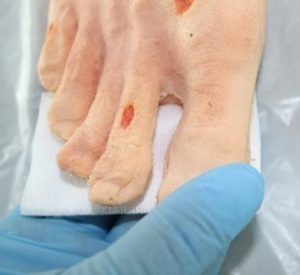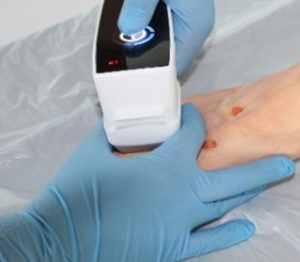FAQ
The duration of therapy depends on the type, history and strain of the wound. Whether a wound responds to the therapy, an experienced wound manager can see after 2-3 applications. Signs of this are, for example:
- Better blood circulation to the wound
- Odour reduction
- Decrease in wound secretion
- Wound area reduction
- Less pain when changing bandages.
In the case of wounds such as amputation stumps, which are exposed to strong mechanical loads, regular follow-up treatment may be necessary.
Plasma can be used against all bacteria and also MRE. Whether the wound reacts to the treatment, the wound manager can see after 2-3 treatments.
Cold plasma can be used on all wounds. The treatment of heavily bleeding wounds and wounds in which the deposits cannot or may not be removed is not recommended, but in principle possible. Link to treatment spectrum.
Basically, any wound can be treated with plasma. But not every wound reacts equally to the treatment.
Basically, the larger the surgical wound and the longer the procedure, the greater the risk of postoperative wound healing disorders.
Postoperative wounds respond excellently to cold plasma, they heal faster. In the case of postoperative wound healing disorders, therapy with cold plasma ensures healthy wound healing.
They heal much faster, this has been observed especially with wounds in problematic areas that are heavily loaded and exposed to impurities.
Plasma care® is not approved for interoperative use.
If the treatment time of 3 minutes of a wound area is not exceeded, plasma does not affect healthy human cells.
Reason why:
During treatment, the cell is exposed to oxidative stress. This stress is a positive stress that stimulates the cell to reproduce and thus leads to cell renewal.
However, since the stress is short-term, it does not become dangerous. No long-term free radicals are formed.
The treatment itself is predominantly perceived by the patients as not painful.
Often the pre-treatment (dressing change, wound toilet) is painful. Patients have reported that this pain even subsides after some cold plasma application.
Wound healing pain: There are very rare cases when patients complain of pain after treatment. This pain is due to the activation of wound healing. The re-onset activity of the wound is sometimes perceived as pain. However, the feeling usually subsides after a few treatments.
In the case of wounds on different parts of the body (for example arm and leg): "No", because then a migration of the germs from one wound to the other is possible. If you were to use the same spacer now, it would lead to cross-contamination.
In the case of adjacent wounds on the same part of the body: "Yes", because the bacteria and germs spread on both wounds anyway.
The device is designed for inpatient and outpatient wound treatment, i.e. even if different users, different patients, treat with the device at different times, on different wards, it must be 100% ensured that the spacer is safe and sterile; Bacteria and germs must under no circumstances be carried from one patient to another. This can only be ensured 100% by a disposable item.
Basically no. Please note the hygiene guidelines that apply to you.
The plasma care® should be placed directly on the wound (if painless), so that a so-called "plasma room" with a high plasma concentration can arise in the spacer.
In anatomically difficult places (fingers/toes, etc.) "enclose" the plasma care® spacer with your fingers or with the help of compresses


Please tampon deep pockets and fistula ducts to avoid overgranulation. If this is not possible, cold plasma treatment should be avoided.
With a fully charged battery, about 120 treatments are possible. BUT: The device can discharge when not in use or cold, so the recommendation => Put the device in the charging station in the evening.
Superficial wipe disinfection should be performed after each patient. The plasma source should only be cleaned if there is visible contamination.
A 3-minute film is available as instructions for cleaning.
